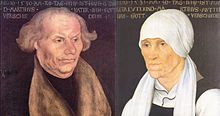Martin Luther was born to Hans Luder (or Ludher, later Luther)
[13] and his wife Margarethe (née Lindemann) on 10 November 1483 in
Eisleben, Saxony, then part of the
Holy Roman Empire. He was baptized as a Catholic the next morning on the feast day of
St. Martin of Tours. His family moved to
Mansfeld in 1484, where his father was a leaseholder of copper mines and smelters
[14] and served as one of four citizen representatives on the local council.
[13] The religious scholar
Martin Marty describes Luther's mother as a hard-working woman of "trading-class stock and middling means" and notes that Luther's enemies later wrongly described her as a whore and bath attendant.
[13] He had several brothers and sisters, and is known to have been close to one of them, Jacob.
[15] Hans Luther was ambitious for himself and his family, and he was determined to see Martin, his eldest son, become a lawyer. He sent Martin to Latin schools in Mansfeld, then
Magdeburg in 1497, where he attended a school operated by a
lay group called the
Brethren of the Common Life, and
Eisenach in 1498.
[16] The three schools focused on the so-called "
trivium": grammar, rhetoric, and logic. Luther later compared his education there to
purgatory and
hell.
[17]
In 1501, at the age of 19, he entered the
University of Erfurt, which he later described as a beerhouse and whorehouse.
[18] He was made to wake at four every morning for what has been described as "a day of rote learning and often wearying spiritual exercises."
[18] He received his master's degree in 1505.
[19]
In accordance with his father's wishes, Luther enrolled in law school at the same university that year but dropped out almost immediately, believing that law represented uncertainty.
[19] Luther sought assurances about life and was drawn to theology and philosophy, expressing particular interest in
Aristotle,
William of Ockham, and
Gabriel Biel.
[19] He was deeply influenced by two tutors,
Bartholomaeus Arnoldi von Usingen and Jodocus Trutfetter, who taught him to be suspicious of even the greatest thinkers
[19] and to test everything himself by experience.
[20] Philosophy proved to be unsatisfying, offering assurance about the use of
reason but none about loving God, which to Luther was more important. Reason could not lead men to God, he felt, and he thereafter developed a love-hate relationship with Aristotle over the latter's emphasis on reason.
[20] For Luther, reason could be used to question men and institutions, but not God. Human beings could learn about God only through divine
revelation, he believed, and
Scripture therefore became increasingly important to him.
[20]
He later attributed his decision to an event: on 2 July 1505, he was returning to university on horseback after a trip home. During a thunderstorm, a lightning bolt struck near him. Later telling his father he was terrified of death and divine judgment, he cried out, "Help!
Saint Anna, I will become a monk!"
[21][22] He came to view his cry for help as a vow he could never break. He left law school, sold his books, and entered a closed
Augustinian friary in
Erfurt on 17 July 1505.
[23] One friend blamed the decision on Luther's sadness over the deaths of two friends. Luther himself seemed saddened by the move. Those who attended a farewell supper walked him to the door of the Black Cloister. "This day you see me, and then, not ever again," he said.
[20] His father was furious over what he saw as a waste of Luther's education.
[24]

















































